7/12/2009
VAIO W Netbook Clone Beats Sony to the Market
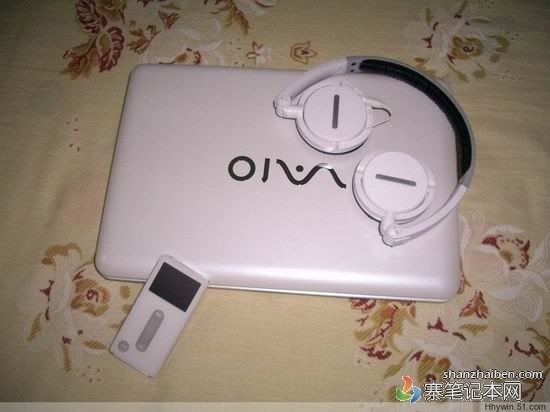
Turns out by the time Sony went official with its inaugural VAIO W netbook, it was already old news to the Chinese KIRF market. The "VAIO" pictured above apparently came out some time in mid-June and does a laudable job of honoring the actual one's chassis, although the keyboard is more traditional than Sony's isolated / chiclet stylings. Throw in a 10.2-inch LED display, 1.6GHz Atom processor, integrated graphics, a 160GB HDD, 1GB RAM, and decently convincing packaging and you'd be liable to think you went through a time warp spotting this in Shenzhen. It's got a pretty sizable head start on the legit version, but something tells us this particular model won't be trying its luck elsewhere in the world.
BlackBerry Storm 2 Specifications, 3G-equipped original en route to AT&T?
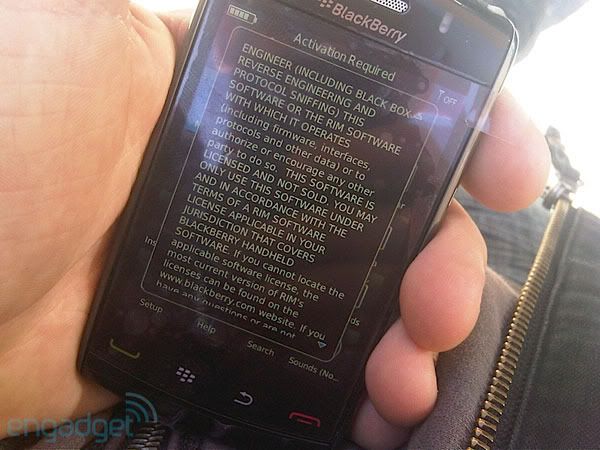
You haven't forgotten about that BlackBerry Storm 2, have you? The Boy Genius Report is claiming it's gotten device specs for RIM's touchscreen-centric maven, also reportedly called the 9550, and while not surprising (and not confirmed), according to his source the CDMA device will be sporting 802.11b/g (which we already sort of knew), a 3.2 megapixel camera, 360 x 480 capacitive touchscreen, and BlackBerry OS 5.0. If that's not enough, the site's also saying a GSM version of the original, with 3G in tow, does exist as the 9520 and is possibly on track for release soon on AT&T and Rogers. All nice fodder for dreams, but we're not getting our hopes up until something more official rears its SurePress-laden head.
Get BlackBerry Tours on Sprint and Verizon
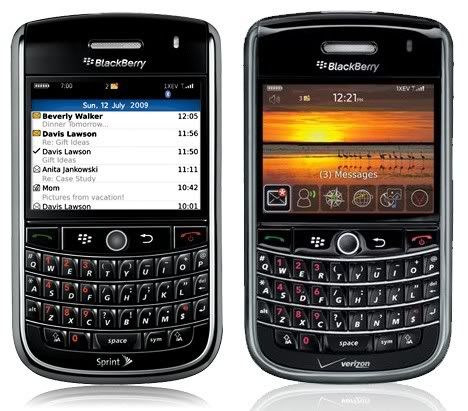
If you've had you eye on the Tour, we bet you didn't forget they were going on sale today -- but just in case you had, consider this your official reminder. Both carriers are now offering RIM's latest and greatest CDMA BlackBerry for $199.99 on contract, so you're probably not going to see a lot of defections between carriers this time around. Pardon us if we don't shed a tear for the lack of exclusivity on this one.
Read - Sprint
Read - Verizon
Google’s Chrome OS to be launched after mid 2010
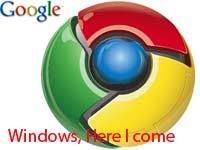 Google today announced the Chrome OS (operating system) for desktops and notebooks throwing a direct challenge to Microsoft's Windows operating system family. This Linux kernel based operating systems has its roots in Google's Chrome browser and is different from Android. Google will be launching the Chrome OS for netbooks in second half of 2010.
Google today announced the Chrome OS (operating system) for desktops and notebooks throwing a direct challenge to Microsoft's Windows operating system family. This Linux kernel based operating systems has its roots in Google's Chrome browser and is different from Android. Google will be launching the Chrome OS for netbooks in second half of 2010.
Basically, Google Chrome OS is intended for those who would want to carry out their regular computing needs via the Internet; it will be designed for ultra portable netbooks as well as full-size desktop systems. This means, the Chrome OS will run on x86 and ARM processors based systems. Google pleads to not confuse the Chrome OS with Android. The Android OS has been designed to work on a variety of devices and platforms like from smartphones to set top boxes.
Sundar Pichai, VP Product Management and Linus Upson, Engineering Director at Google, stated in a blog post that 'there are areas where Google Chrome OS and Android overlap, we believe choice will drive innovation for the benefit of everyone, including Google'.
Google Chrome OS's architecture is based on Google Chrome running on the top of Linux kernel. This operating system will use Web as the platform, therefore all the existing web-based applications will automatically work. New applications would be written using the current generation web technologies. Key aspects of the Chrome OS would be speed, simplicity and security.
Google is designing this OS to be faster to boot, and to be able to connect the user to Web within seconds of its start up. Just like Google's Chrome browser was treated for security, the Chrome OS will get the same security treatment by the redesigning basic OS architecture.
Chrome OS is a smart step by Google since Android doesn't run on x86 processor architecture, though ports do exist. Hence, Google touts that Chrome OS is all about the Web, making the OS experience faster, lighter and free from any sort of malware, viruses and security updates. Google plans to release Chrome OS for netbooks in second half of 2010. Till then, the Chrome OS's alpha versions will be tried and tested on various grounds that include processing, connectivity, stability, security and more.
IPhone to Overtake Nokia By 2012?
A research firm Generator Research in a recently published report has confirmed Nokia's worst fears. At current rates of growth, the iPhone is likely to challenge Nokia's dominant position in the smartphones sector and possibly overtake it by 2012 - just three years from now. The research predicts that Nokia will lose its market share and will drop to 20% from its current 40% share.
 The report backs up its predictions stating quite a few reasons for the iPhone's increasing dominance. These include the affordability of the device and the increased chances of its availability on other networks.
The report backs up its predictions stating quite a few reasons for the iPhone's increasing dominance. These include the affordability of the device and the increased chances of its availability on other networks.
That said, other manufacturers and factors seem to have been not taken into account whilst generating this report. For example, the effect of other players in the smartphone arena, like RIM, Android OS, Windows Mobile and even the upcoming Symbian Open Source OS are bound to have a say in the war that decides the outcome of this battle by the year 2012.
Google Announces Partners for Chrome OS
Now that Google Chrome OS has been announced, the partners who would be working with Google have also been declared. Of the many players in the technology space, Google has chosen Acer, Adobe, ASUS, Freescale, Hewlett-Packard, Lenovo, Qualcomm and Texas Instruments as Chrome OS supporting partners.
 It's a bit surprising that Google managed to rope in four major PC makers, which include Acer, HP, Asus and Lenovo but left out Dell.
It's a bit surprising that Google managed to rope in four major PC makers, which include Acer, HP, Asus and Lenovo but left out Dell.
The Chrome OS is an open source project and will be available and accessible to all for free. Well, we already have a Linux-kernel based Ubuntu for free, but that's a different story.
Following the Chrome OS announcement, Google's VP Product Management and Linus Upson, Engineering Director, Sundar Pichai wrote a short blog post on the official Google blog FAQ about the Google Chrome OS. In the post he mentioned that the OS would be open source and the source code would be publicly released later this year.
Digital Tablets for Artists by Genius!
Genius, a provider of PC peripherals, has introduced two new digital tablets for designers and artists. The EasyPen i405 and MousePen i608 are dual platform tablets that work on both PCs as well as Macs.
 The EasyPen i405 comes in a form factor of 4" x 5.5" while the MousePen i608 has a larger 8" x 6" working area, accompanied by a cordless scroll mouse. The EasyPen i405 has 28 programmable 'hot-keys', while the MousePen i608 has 29, that allow you to access common office and Internet functions at the click of a button. The cordless pen features 1024-level pressure sensitivity and two clickable buttons for controlling shapes and thickness while drawing or writing.
The EasyPen i405 comes in a form factor of 4" x 5.5" while the MousePen i608 has a larger 8" x 6" working area, accompanied by a cordless scroll mouse. The EasyPen i405 has 28 programmable 'hot-keys', while the MousePen i608 has 29, that allow you to access common office and Internet functions at the click of a button. The cordless pen features 1024-level pressure sensitivity and two clickable buttons for controlling shapes and thickness while drawing or writing.
Both tablets can be used to write, draw, sketch and/or sign documents -- thereby saving on paper. Users also have the ability to edit their photos, make comments, personalize documents, etc. Creative professionals as well as first timers can use the digital tablets for drawing, illustrations, digital paintings, etc. without spending too much money.
These Genius Tablets aren't available in India yet. We're awaiting price and availability information from the company. Watch this space for updates!
Sony Ericsson Rachael has got an Impressive UI !
Just a few days ago the Sony Ericsson 'Rachael' or the Xperia X5 was leaked to the world and some of the probable specs revealed. The phone was certainly impressive - at least the specs were.
Just two days later we have a video made public (along with a fresh set of pics) that shows an impressive Sony Ericsson UI running atop Android on what is seemingly an emulator (emulating the X5, of course).
Just to remind you, the 'Rachael' as this one has been codenamed boasts of a Snapdragon processor, an 8 megapixel camera with auto-focus, 7.2Mbps HSDPA and 3D graphics. I guess you should take a look at the video and judge for yourselves.
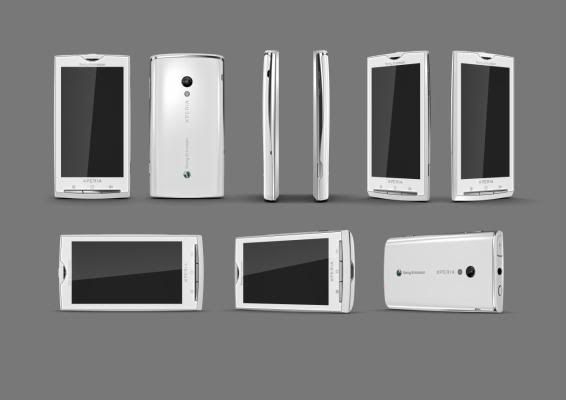
Hope this one comes without further delay and of course may it should be devoid of bugs right from the word go. We trust you on this Sony Ericsson!
Nokia 3720 Classic Phone – A Rough & Tough Candidate!
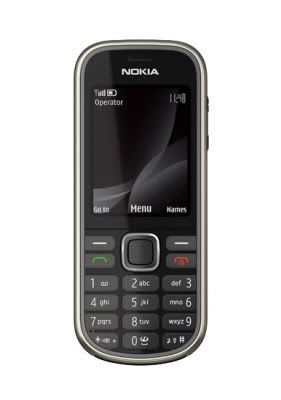
Nokia has officially announced its latest "rugged" entry into the market in the form of the 3720 Classic, an IP-54 certified phone designed to resist water, dust and shock. The Nokia 3720 classic is encased in durable materials and is entirely sealed to protect the inner electronics.
The phone also boasts of a leak proof design that will protect the "insides" of the phone when subjected to extreme stress. Even the battery cover is locked with a screw enabling trouble free usage in muddy and dusty conditions. On the features front, the 3720 Classic sports a 2.2" display, expandable memory support and pre loaded Nokia maps software .There is an LED flashlight thrown in as well to help you out if you're stuck in some tunnel.
The Nokia 3720 is expected to retail for approximately EUR 125 (Rs. 8500) before subsidies or taxes and is expected to begin shipping this summer.
Kingmax’s 16GB Waterproof SD Card!
 Kingmax, a manufacturer and supplier of DRAM and flash products, has announced the waterproof SD card with 16GB storage.
Kingmax, a manufacturer and supplier of DRAM and flash products, has announced the waterproof SD card with 16GB storage.
Based on Kingmax patent PIP technology, the new SD card is waterproof, dustproof and can perform in extreme weather conditions. The PIP technology has passed the waterproof test and receives IPX7 (equivalent to JIS waterproof grade 7) certificate from SGS. In addition, the unique packing technology safeguards the new SD card from piracy, claims the company.
Moreover, the card has built-in ECC (Error Correcting Code) to detect and correct transfer errors and supports CPRM (Contents Protection for Recordable Media) mechanism to ensure the licensed contents could be duplicated safely.
The new SD card also complies with RoHS, halogen free and PFOS/PFOA directives. Available in 2GB, 4GB, 8GB and 16GB capacities, the card carries the global lifetime warranty. The 2GB card is priced at Rs. 1,370.
Mobile Number Portability May Be Delayed – Once More!
 The government's much-hyped mobile number portability (MNP) plan has hit a roadblock. Minutes of the meeting on MNP, indicates that access service providers have indicated that MNP roll out in a phased manner is not feasible.
The government's much-hyped mobile number portability (MNP) plan has hit a roadblock. Minutes of the meeting on MNP, indicates that access service providers have indicated that MNP roll out in a phased manner is not feasible.
Other issues raised include:
- Problems in call routing and charging in the MNP scenario
- No pan-India readiness for MNP; and
- Difficult to meet the government set deadline for implementing MNP
There is also a technical clash between location routing numbers (LRNs) and STD codes in at least 200 sites.
Department of telecom (DoT), however, has asked all service providers to adhere to the timeline.
The government has set a time line for implementation of the first phase of MNP as September 2009.
MJ’s Funeral Records 2nd Largest Traffic
 First, it was the Obama inauguration and now live coverage of Michael Jackson's funeral which triggered the maximum traffic on Akamai.
First, it was the Obama inauguration and now live coverage of Michael Jackson's funeral which triggered the maximum traffic on Akamai.
Akamai received the second largest day ever in terms of total online traffic with the live coverage of the funeral services of Michael Jackson.
Akamai said it delivered more than 2,185,000 live and on-demand streams in Flash and Windows Media formats. Total traffic on the Akamai network surpassed a rate of more than 2 terabits per second during the memorial service.
The largest day on the Akamai network in terms of total traffic on its network was the Obama inauguration live streaming in January 2009.
Akamai also delivered 548 Gbps of live and on-demand Flash streams utilizing Adobe Flash technology.
Microsoft launches Silverlight 3 – Adobe Flash’s Rival
 Microsoft has rolled out Silverlight 3 with a lot of new stuff including the Smooth screening feature. Silverlight is a browser plugin that enables rich media experience, audio playback, vector graphics and animation. Silverlight 3 was released a day early, as it was supposed to be out officially on July 10. Currently, Silverlight 3 supports Internet Explorer 6/7/8, Firefox 2/3 and Safari 3/4 browsers - no support for Opera and Chrome browsers.
Microsoft has rolled out Silverlight 3 with a lot of new stuff including the Smooth screening feature. Silverlight is a browser plugin that enables rich media experience, audio playback, vector graphics and animation. Silverlight 3 was released a day early, as it was supposed to be out officially on July 10. Currently, Silverlight 3 supports Internet Explorer 6/7/8, Firefox 2/3 and Safari 3/4 browsers - no support for Opera and Chrome browsers.
Microsoft's Silverlight is a direct rival of Adobe Flash and is available for download from Microsoft's Silverlight site.
This new Silverlight 3 RTW (3.0.40264.0) version brings along a number of features, including Smooth Screening, GPU hardware acceleration, H.264/AAC/MPEG-4 Video support, and out-of-the-browser experience without any additional plugin downloads. Thousands of other API features are enumerated by Tim Heuer, program manager for Microsoft Silverlight.
Microsoft touts that Silverlight 3 brings streaming of high-definition video in full screen with stutter-free live and on-demand video. For a demo of Smooth Screening, head to this special link for checking out the Smooth Screening experience of playing HD video at any point of time, instantly. The third version will allow streaming of 720p HD content over the web with an ability to Pause and Rewind the video.
The GPU hardware acceleration support will allow this framework to make the best of the available graphics in the user's system. Apart from that, version 3 is a mash up of streaming video and offering Rich Internet Applications experiences. Developers would be able to create Silverlight based apps so that videos can be seen even if the browser is shut off.
A Canon Printer for Bad Photos!
By the time you’re ready to print a photo, chances are you have optimized the image by 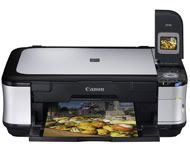 adjusting your camera settings before you snap and maybe even Photoshopped it afterward. Now you have a third line of defense against bad photos: Canon has announced three new printers with technology that it says can resolve common photo-printing flaws.
adjusting your camera settings before you snap and maybe even Photoshopped it afterward. Now you have a third line of defense against bad photos: Canon has announced three new printers with technology that it says can resolve common photo-printing flaws.
The company says its two new Pixma all-in-one (print/copy/scan) devices employ Auto Photo Fix II technology to correct errors through exposure correction and improvements in face detection and scene analysis, plus brightness and saturation correction. The new Pixma inkjets also include software that enables users to target and print a specific area of a Web page, rather than printing an entire page (or pages), an eco-friendly option that will result in paper and ink savings.
The $150 Pixma MP560 Wireless2 Photo AIO Printer has built-in Wi-Fi connectivity and two-sided printing, another great way to conserve resources (although it will slow your print job). This new AIO Printer can print photos directly from a U.S.B. thumb drive, a new capability. (All the new Canon devices accept a wide variety of camera memory cards.) Canon says the Pixma MP560, which employs five inks, can deliver borderless 4-by-6-inch prints in about 39 seconds.
One step down is the $100 Pixma MP490 AIO Photo Printer, a four-ink system that can print a 4-by-6-inch photo about in 43 seconds. It lacks Wi-Fi connectivity but does include a U.S.B. slot for computer-less printing.
And for those who want to take a printer to the party, Canon has updated its Selphy line to  include the $180 CP790 Compact Photo Printer. The CP790, like its predecessor, the CP770, comes in its own carrying “basket” (it looks more like a bucket, really) that houses the printer, as well as accessories like paper, ink cartridges and the power cord. Those who want to be truly mobile can also toss in an optional $80 battery.
include the $180 CP790 Compact Photo Printer. The CP790, like its predecessor, the CP770, comes in its own carrying “basket” (it looks more like a bucket, really) that houses the printer, as well as accessories like paper, ink cartridges and the power cord. Those who want to be truly mobile can also toss in an optional $80 battery.
Canon says the new Selphy yields better photos than last year’s model because of a new portrait-image optimization feature and face-detection brightness correction. The CP790 can output a 4-by-6-inch print in 43 seconds, according to the company.
The Selphy CP790 will be available this month, but you’ll have to wait until August for the new Pixma printers.
Twitter Nabs a Lawyer from Google
Twitter, the popular micro-blogging service, has stolen a prominent Google lawyer.
The startup has hired Alexander Macgillivray, deputy general counsel for products and intellectual property at Google, to be its general counsel, according to a person with knowledge of the hiring.
Mr. Macgillivray has been an important member of the Google legal team, spearheading the controversial settlement with authors and book publishers over Google’s scanning of millions of out of-print library books. The settlement, if accepted by a federal judge, will clear the way for Google to make available online millions of historic books that would otherwise be difficult to access. The Justice Department has said it is inquiring into whether that settlement violates anti-trust laws.
Mr. Macgillivray, 36, has also represented Google in a wide variety of other matters, including Viacom’s copyright lawsuit against YouTube and complaints from the Associated Press that Google improperly used its content.
Before he joined Google, Macgillivray was with Wilson Sonsini Goodrich & Rosati, the prominent Silicon Valley law firm.
Twitter’s legal issues, at least for now, revolve around issues of trademark and impersonation. Tony La Russa, St. Louis Cardinals manager, sued the company earlier this year, saying it did not do enough to prevent someone from falsely using the service in his name. He later dropped the suit.
Twitter is looking to expand its staff as it tries to evolve from online phenomenon to a money-making business. In addition to about a dozen engineering jobs that are listed on the site, the San Francisco startup has been interviewing possible candidates for the position of chief financial officer, according to a person familiar with the search.
Need to Protect Federal Sites in Wake of Cyberattacks
 The network attacks that severely disrupted several federal agency Web sites this week highlights the need for the government to quickly finish implementing its ongoing consolidation of Internet access points, the former de facto CIO of the federal government and others said today.
The network attacks that severely disrupted several federal agency Web sites this week highlights the need for the government to quickly finish implementing its ongoing consolidation of Internet access points, the former de facto CIO of the federal government and others said today.
Multiple government Web sites, including that of the Federal Trade Commission (FTC), the Federal Aviation Administration (FAA) and Department of the Treasury, were temporarily knocked out or slowed down earlier this week by a wave of distributed denial of service attacks.
The attacks were launched from a botnet believed to comprise of nearly 50,000 infected computers, and were designed to render Web sites inaccessible by inundating them with useless traffic.
Security researchers have described the attacks as being relatively unsophisticated. Even so, the attacks still managed to totally shut down the Web sites of the FTC and Department of Transportation for several hours over the weekend, according to statistics available from Internet monitoring firm Keynote Systems.
The most important lesson learned is that many federal agency security people did not know which network service provider connected their Web sites to the Internet, said Alan Paller, director of research the SANS Institute. "So they could not get the network service provider to filter traffic," Paller said.
The problem has to do with that federal agencies have more access points to the Internet than they know how to monitor or to manage, said Karen Evans, former de facto CIO of the federal government during the Bush administration.
An initiative called the Trusted Internet Connections (TIC) program, which was launched in November 2007, is designed to tackle this issue by getting agencies to drastically reduce the number of individual external network connections, including those to the Internet.
Since the effort was launched, the number of access points across government has been reduced from more than 4,300 to about 2,750, per the last time data on the effort was publicly released in June 2008. The goal is to whittle that number down to about 80.
Instead of having each individual agency manage its own connections, the plan is to have a small group of TIC access providers offering centralized connectivity and gateway-monitoring services to a majority of civilian federal agencies. While 16 agencies will act as their own access providers, 121 others will have their connections managed via a U.S. General Services Administration-approved service provider.
Such a consolidation of access points and management functions would allow for much better network monitoring, filtering and incident response than is possible today across civilian government, Evans said.
"The TIC initiative is about closing down external access points so that you can then monitor traffic in a way that allows you to take more strategic [actions to protect federal networks against threats]," she said.
The model would be similar to the one in existence across Department of Defense networks, Evans said. "The DoD works as a single enterprise. They manage their network as a corporate asset and they do things in accordance with a framework" that is consistent across the .mil domain she said.
"They have been working on this for several years. They know where their external access points or so they are monitoring them," in better fashion than civilian agencies are, she said.
As a result, DoD networks are better prepared and equipped to respond in a more coordinated fashion to attacks of the sort witnessed this week, she said. Evans said that after this week's attacks it won't be surprising at all if more agencies move faster to the TIC model than they have been.
"TIC offers a capability to immediately block those offending IP addresses that are launching an attack," said Patricia Titus, former chief information security officer at the Transportation Security Administration (TSA), who now holds a similar job at Unisys Corp.
But a lot will depend on how securely it is architected, Titus said. A major component of TIC is a federal network monitoring technology called Einstein that is designed to capture anomalous network activity and flag suspicious behavior in near real-time.
If this component is not well implemented, the network access point consolidation could end up giving attackers a central point to go after federal systems, she said. But she added it is "very unlikely" that such an implementation error would be allowed to happen. "The government has put out a very careful thought out architecture. This is something they are definitely paying attention to."
Details on the consolidated access points will also not be publicly published making them harder to find and therefore to attack, Evans said.
This week's attacks show how federal agencies continue to remain vulnerable to network threats despite having relatively sophisticated, well-funded and well-staffed security operations, said Amit Yoran, former director of the National Cybersecurity Division at the U.S. Department of Homeland Security (DHS).
"If this can happen to organizations such as the ones affected, it certainly can happen to people downstream as well," said Yoran, who is now CEO of security vendor NetWitness Corp. The attacks show the need for organizations to centralize security policy and enable persistent monitoring of network ingress and egress points in the manner being contemplated by TIC, Yoran said.
"If you don't have consistent monitoring of access points then the risk accepted by one gateway or one component of your network is effectively shared by all participants in the enterprise," he said.
Nobel Prize for Twitter!
Twitter and its creators are worthy of being considered for the Nobel Peace Prize for the role they played during the recent civil unrest in Iran, according to a former U.S. national security adviser.
Mark Pfeifle, a former aide for George W. Bush, suggests that Twitter be considered for the Nobel Peace Prize, which is awarded to those who push for "fraternity between nations" and for "holding the promotion of peace," reports Brand Republic.
Previous winners of the Nobel Peace Prize include Mother Teresa, Mikhail Gorbachev, Martin Luther King Jr, the Dalai Lama, Nelson Mandela, and Apple board member Al Gore.
Writing in the Christian Science Monitor, Pfeifle said: "When traditional journalists were forced to leave the country, Twitter became a window for the world to view hope, heroism, and horror."
"It became the assignment desk, the reporter, and the producer. And, because of this, Twitter and its creators are worthy of being considered for the Nobel Peace Prize."
"I first mentioned this idea while being interviewed on a cable news program [Fox News]. Many scoffed. That's understandable. But think about what Twitter has accomplished: It has empowered people to attempt to resolve a domestic showdown with international implications - and has enabled the world to stand with them. It laid the foundation to pressure the world to denounce oppression in Iran.
"Twitter has been criticized as a time-waster - a way for people to inform their friends about the minutiae of their lives, 140 characters at a time. But in the past month, 140 characters were enough to shine a light on Iranian oppression and elevate Twitter to the level of change agent. Even the government of Iran has been forced to utilize the very tool they attempted to squelch to try to hold on to power.
"Without Twitter, the world might have known little more than a losing candidate accusing the powers that be of alleged fraud. Without Twitter, the people of Iran would not have felt empowered and confident to stand up for freedom and democracy. They did so because they knew the world was watching. With Twitter, they now shout hope with a passion and dedication that resonates not just with those on their street, but with millions across the globe. "
Pfeifle also commended other social media sites such as Facebook -- on which Iranian presidential candidate Mir Hossein Mousavi has amassed more than 100,000 supporters.
At the height of the Iranian protest activities more than 221,000 Iran tweets were sent in an hour. In one day, 3,000 Iranian videos were uploaded on YouTube, and 2.2 million blog entries were posted.
Mark Pfeifle was deputy national security adviser for strategic communications and global outreach at the National Security Council from 2007 to 2009. In January 2009 Fort Leavenworth Commander and former Iraq War spokesman LTG William B. Caldwell awarded Pfeifle the Army's Outstanding Civilian Service Award for "dramatically improved communication planning and strategies... in support of the Global War on Terror."
2010 Census To Go Wireless Courtesy Sprint
 When the government conducts its census next year, Sprint will be providing wireless equipment, coverage and secure connections to workers out in the field.
When the government conducts its census next year, Sprint will be providing wireless equipment, coverage and secure connections to workers out in the field.
Managing telecommunications for the census is no simple task, of course. The company estimates that it will need to provide census-takers at Harris Corporation with 500 MPLS sites, 150,000 active telemetry wireless devices and about 1,500 managed devices and mobile broadband connection cards. Bill White, Sprint's vice president of federal programs, says that the 150,000 telemetry devices were custom-built by HTC and were wirelessly connected by Sprint to help tie together the 450 local census offices that Harris is operating.
The big goal is for Sprint to provide census workers with secure connections that will allow them to wirelessly transmit sensitive data over a secure connection to the Harris Field Data Collection Automation (FDCA) database for safe storage. White says that one of the big advantages that Sprint has in helping take the census is its private wireless network that allows government and enterprise users to securely link between their wireless devices and their central server without using the public Internet.
"One of the unique aspects of our wireless capabilities is the ability to securely transmit information from a wireless handheld computer to a server farm without using the public Internet," he says. "With traditional wireless data services, once information leaves the device it goes over the Web."
Sprint says that its coverage capabilities give it another advantage in tackling the census, as its wireless capabilities "exceeded" the Harris's program requirements. For areas where the carrier's wireless coverage isn't as strong, it's implementing an IP dial-up service that will provide users with a secure, albeit antiquated, way of transmitting data.
"We've found a way of doing this that uses both old and new technology to make connections," says White. "The type of information that is sent through the census computers tends to be short bursts of data stream. While we do have a dial-up service available, we're confident that our wireless services cover a large majority of the country."
Wozniak's Storage Start-up Bosters Flash
Fusion-io, the flash storage start-up with Steve Wozniak as its chief scientist, says it can now manage commercial-grade flash memory in a way that ensures enterprise-class reliability.
This means Fusion-io can offer less expensive disks to customers while sacrificing little in terms of performance and endurance, the company said Tuesday.
The announcement focuses on the differences between multi-level cell (MLC) flash chips, used primarily for consumer devices; and single-level cell (SLC), primarily used in enterprise applications.
MLC, the less expensive version, fits twice as much storage capacity into the same amount of silicon as SLC, but is less reliable with more misreads and errors, says CTO David Flynn.
"The single-level cell is a niche product targeting only enterprise SSDs, not even consumer SSDs," Flynn says. "Because it's a niche it costs four times as much per bit."
Fusion-io announced Tuesday that it is releasing new products that take MLC chips and cut the usable storage capacity in half, while eliminating most of the potential for errors. This allows the use of a less expensive type of flash for enterprise-grade applications.
"We're taking off-the-shelf MLC and using it in a way where it acts as if it were SLC," Flynn says.
Earlier this year, Fusion-io landed $47 million in venture funding, and announced that Apple co-founder Wozniak had taken a full-time position as the company's chief scientist.
Fusion-io's ioDrive products are PCI Express (PCIe) cards that are loaded with flash memory and inserted directly into servers. The company already offered both SLC and MLC products and is dubbing its new line of tools "SMLC."
The SMLC devices "closely approximate" the performance and endurance of SLC, but are not 100% accurate, Flynn says. Therefore, some enterprises will still prefer to use SLC for write-intensive workloads.
SMLC will be available later this month in 160GB and 320GB ioDrive cards. Fusion-io did not release specific pricing but said it would be about halfway between the price of SLC and MLC. A typical Fusion-io MLC product costs about $15 per gibabyte while the company's SLC costs about $30 to $40 a gigabyte.
Research Shows that Online Shoppers Still Don't Get Enough Security!
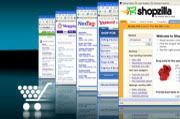 People are increasingly dependent on e-commerce sites, but they do not have a good understanding of online security.
People are increasingly dependent on e-commerce sites, but they do not have a good understanding of online security.
That is the key verdict of new research, which found 70 percent of online buyers blame themselves for security problems, but keep on buying. (See also "8 Web Sites That Will Save You Cash.")
Under a quarter blamed the website or technology for security issues, according to the report 'Online security: a human perspective,' commissioned by Oracle and conducted by consultancy Foviance. Some 550 people were interviewed.
The report highlighted issues over consumers' understanding of security, stating that perceptions were "press-led." They had "no desire" to learn more about IT security, and unrealistic expectations about their rights if their security is compromised, it said.
Two-thirds wanted more online security, but many still said that if this meant slower transaction processing, then they would find it frustrating. Some 72 percent of consumers had experienced problems with online transactions, including slow processing speed or too many steps to go through.
This created a "dilemma" for online retailers, the report said, as they weighed up improving security against making user experience strong. Most of those interviewed said they did not want two-factor security authentication outside the banking sector.
The report advised e-commerce sites to reassure customers about security, including demonstrating third party certification logos, security policies, customer reviews, terms and conditions, and a confirmation page or email.
A "layered" approach was necessary, it said, covering security from the website itself to back-office systems processing and storing customer data.
"It's time to stop viewing IT security as a castle and moat. Companies need to take a more sophisticated approach and that requires a shift in mindset," said Des Powley, security director at Oracle UK.
Is Facebook a Billion-Dollar Business?
 Facebook board member, Silicon Valley entrepreneur, and Web browser pioneer Marc Andreessen says that social networking site Facebook will earn more than $500 million and will make many billions of dollars in revenue in five years.
Facebook board member, Silicon Valley entrepreneur, and Web browser pioneer Marc Andreessen says that social networking site Facebook will earn more than $500 million and will make many billions of dollars in revenue in five years.
He told Reuters, "This calendar year they'll do over $500 million. If they pushed the throttle forward on monetization they would be doing more than a billion this year.
"There's every reason to expect in my view that the thing can be doing billions in revenue five years from now."
Andreessen is starting his own venture capital fund with Netscape executive Ben Horowitz, and now regrets not investing in Facebook: "I probably could have if I had tried hard but I didn't."
Andreessen did invest in micro-blogging site and Facebook competitor Twitter.
Speaking to Reuters Andreessen even claimed that Facebook could earn more than a billion dollars this year if it pushed harder on selling advertising.
However, he said that it was more important at this stage for social sites like Facebook and Twitter to retain and grow their user base and capture market share, rather than worry too much about making lots of money right away.
Horowitz pointed to the once-dominant social network MySpace, now owned by Rupert Murdoch's News Corporation. He believes that MySpace focused too much on selling advertisements and not enough on developing the platform: "If the revenue degraded the user experience then that was a very dangerous thing to do," Horowitz said.
Andreessen devised the Mosaic web browser, which is still influential in the code of most of today's commercial browsers. He founded Netscape and also most recently the topic-oriented social network Ning.
Appealed : Another Music Piracy Verdict
 The woman ordered to pay $1.92 million in fines for illegally distributing 24 copyrighted songs said she will appeal, and called the June 18 jury verdict "excessive, shocking and monstrous."
The woman ordered to pay $1.92 million in fines for illegally distributing 24 copyrighted songs said she will appeal, and called the June 18 jury verdict "excessive, shocking and monstrous."
In a 13-page motion filed in federal district court in Duluth last week, Jammie Thomas-Rasset implored the judge to overturn the verdict, reduce the damages to the statutory minimum, or to order a new trial.
Thomas-Rasset was accused by six music companies of illegally distributing a total of 1,702 copyrighted songs over the Kazaa file-sharing network. Their lawsuit itself though focused on a representative sample of just 24 of those songs.
A jury which first heard her case back in October 2007, found Thomas-Rasset guilty of illegal music distribution and ordered her to pay the six companies a total of $222,000 in damages.
That decision was later overturned on technical grounds by U.S. District Judge Michael Davis the federal judge in charge of the case and a retrial was ordered last year.
The retrial, which took place in June, lasted four days and ended with the new jury also finding Thomas-Rasset guilty of illegal music distribution, and hit her with the $1.92 million fine -- about nine times the $222,000 that had been assessed against her in the first trial.
In her motion, Thomas-Rasset said that the fine assessed against her in the retrial exceeded the constitutional limits on civil punishment and appeared designed explicitly to deter others rather than to compensate the six music companies that had sued her for piracy.
A civil punishment is unconstitutional if the penalty far exceeds the actual damages the plaintiffs might have suffered, as happened in this case where the jury fined her $80,000 for each song she allegedly pirated, Thomas-Rasset said.
"Here, where the punishment ratios are 1:62,015 measured in songs and 1:5,333 measured in albums, the verdict is both monstrous and shocking," Thomas-Rasset said in her motion.
Though the Copyright Act, under which Thomas-Rasset was sued, allows for statutory damages of up to $150,000 per song, her lawyers urged the judge to consider lowering the damages to $18,000, or $750 per song, which is the minimum available under the law.
In making the request, Thomas-Rasset's lawyers noted that their client "was a single mother who, at worst, downloaded and shared some music on Kazaa, music for which she had already lawfully purchased the CDs, without any hint at all of a commercial motive."
In their motion, Thomas-Rasset's lawyers yesterday also asked the judge hearing the case to order a new trial. The lawyers argued that much of the evidence used against her in court had been improperly collected by Media Sentry Inc, a firm working on behalf of the Recording Industry Association of America (RIAA).
They said the evidence gathered by Media Sentry should have been suppressed because the company had collected the information without first obtaining a private investigator's license as it was required to. A similar motion filed before the trial began was rejected by the judge.
The Thomas-Rasset case has attracted considerable attention because it is the first RIAA music piracy case to actually go to trial, even though the trade association has slapped copyright lawsuits on thousands of individuals over the past few years.
The case has often been used as an example of what many say are the excessive and unconstitutional damages being sought by the RIAA in its effort to scare people off online copyright infringement.
Last month's verdict added to those concerns with several rights groups blasting the damages and calling it outrageous and unfair. The RIAA itself has consistently maintained that it has been willing to negotiate a settlement with Thomas-Rasset all along and that the case went to court only because of her refusal to settle.
RIAA spokeswoman Cara Duckworth said by e-mail that Thomas-Rasset has now been found liable twice by two different juries. She said that although yesterday's motion is "saturated" with mentions about the 24 songs at the middle of the case, it ignores the fact that the total number of songs distributed by Thomas-Rasset was actually more than 1,000.
"Both juries repeatedly heard that Ms. Thomas-Rasset was caught illegally downloading and distributing more than 1,700 songs to at least 2.3 million people on the Kazaa file-trading network," Duckworth said. "[That's] like standing on a busy street corner with 150 CDs and giving out free copies to everyone who walks by."
Apple still silent on Iphone Complaints!
 The iPhone 3GS has been an undeniable marketplace hit since its release on June 19, and will likely continue to soar in sales despite three customer complaints that have surfaced recently. The big three gripes: the iPhone 3GS battery life is dismal, the 3GS overheats, and there's a serious SMS vulnerability.
The iPhone 3GS has been an undeniable marketplace hit since its release on June 19, and will likely continue to soar in sales despite three customer complaints that have surfaced recently. The big three gripes: the iPhone 3GS battery life is dismal, the 3GS overheats, and there's a serious SMS vulnerability.
Historically, Apple does a poor job of sharing details about its technology and is sometimes slow to respond when such complaints arise or Apple's response falls short of expectations, analysts say. "Apple needs to get better at this so that buyers can understand what the limitations are upfront," says Gartner analyst Ken Dulaney. "This is why Apple and the enterprise have a somewhat rocky relationship."
[Apple offers tips on how to prevent the iPhone from overheating, reports CIO. Also, Apple plans to patch a serious SMS vulnerability on the iPhone.]
The biggest complaint concerns a short battery life, which is ironic since Apple touted improvements of the iPhone 3GS battery at its Worldwide Developers Conference last month. Among those claims, Apple said the iPhone 3GS would deliver 9 hours of use on Wi-Fi, 10 hours of video playback and 30 hours of music on a single charge-about a 30 percent upgrade to the iPhone 3G. Indeed, the iPhone 3GS battery is physically a little bigger than the one in the iPhone 3G.
More than a few users, however, have reported that the iPhone 3GS drains the battery quickly. The problem may be that the software isn't managing power efficiently, analysts speculate. For instance, iPhone OS 3.0 supports push notification-that is, alerts-when apps aren't running. The iPhone constantly buzzes during an instant message chat even if you're on the computer and not the iPhone. This could be draining the battery if the software isn't handling push features properly. If so, the problem won't be fixed until the next OS update.
Apple's response? An Apple spokeswoman told the LA Times that battery life is highly dependent on usage-so if you don't change your usage pattern from the old iPhone 3G, then performance shouldn't change either. It was a lukewarm response to a potentially serious problem, analysts say. "The battery is the first concern because it could be potentially dangerous," Dulaney says, "and we have no clue, except for some dos and don'ts, why it's happening."
Last week, some iPhone 3GS users also began noticing that their cool new devices were overheating: Some units with the white casings turned burnt-brown. Other issues surfaced, such as rattling noises and high-pitch sound emissions. Apple responded by issuing a set of simple guidelines to prevent overheating-guidelines that did little to put out the fire.
One of Apple's tips: "iPhone 3G and iPhone 3GS should be used in environments where temperatures remain between 32 degrees and 95 degrees Fahrenheit. Temperatures outside of this range could decrease battery life temporarily or effect performance." Here's another: "Avoid using data intensive applications, like GPS or streaming-media apps, for extended periods of time on hot days or while in direct sunlight."
The most serious of the iPhone's problems concerns a new SMS vulnerability that could allow an attacker to remotely install and run unsigned software code with root access to the iPhone. Security expert Charlie Miller, who hacked a Mac via Safari in 10 seconds at this year's PWN2Own contest, said in a presentation that the weakness is in the way iPhones handle text messages.
The seriousness of this problem has spurred Apple's intent; Apple is reportedly working on a patch that should be available later this month. "I believe that the SMS vulnerability may be the most pressing, since stories of hijacked, zombie, misbehaving iPhones are more likely to leave a long-lasting negative impression than are the heat and battery life issues," says Forrester analyst Charles Golvin.
But is the vulnerability an Apple or AT&T problem? Does it affect other manufacturers? Apple's lack of formal releases and documentation frustrates analysts like Dulaney. For instance, Apple said the iPhone OS 3.0 SDK released earlier this year has hundreds of new features - "but you can't really find them," Dulaney says.
Dulaney also points to Apple's lackluster documentation practices with the iPhone 3GS hardware-based encryption. "You can't find out how the encryption is done," he says. "For those who know encryption, it's not a simple word. It's about how it's implemented."
Spotted – Tweaked UI in Snow Leopard
 Despite having showed no changes to the OS X UI at WWDC, it looks like there are at least a few tweaks in the new test build. Could the minor changes spotted already indicate more are to come this fall?
Despite having showed no changes to the OS X UI at WWDC, it looks like there are at least a few tweaks in the new test build. Could the minor changes spotted already indicate more are to come this fall?
We all know Snow Leopard was designed for speed and stability rather than a UI upgrade, but that doesn't mean Apple won't include a whole bunch of tweaks at the same time. Ars Technica has spotted a few in a new test build of the OS. For one, the right-click menus in dock items is changed to a white text on black background, as in Stacks, rather than the staid black-on-white it is now. It's not a big deal, for sure, but we wonder if it means there'll be a bunch more tweaks for the sake of consistency. There are three months left until Snow Leopard's September release date, so who knows what Apple can bang out before then.
Teen Falls into Open Manhole, Texting!

As if you needed more evidence that texting is more dangerous than swine flu, a 15-year-old girl from Staten Island walked into an open manhole while texting. She's fine, don't worry, although she did lose a shoe in the sewer.
Alexa Longueira fell about 4 or 5 feet into an open manhole in Staten Island, scraping up her back and shoulders in the process, although she is otherwise physically unharmed. Her mother noted that she was also mentally injured, as the sewer was "putrid" and one of her shoes remains down there. Apparently, there were some DEP workers on the scene who were "looking" for cones to mark the area when the girl fell in.
The Longueira family says they will sue, although it's not clear exactly who—the city? The cellphone company? Alexa herself, for not watching where she was walking? Regardless, we are all allowed to laugh at this story, at teenagers with their texting, and at Staten Island as a whole, because the girl is unhurt. Proceed.
Gizmondo Head (Yes, the one who crashed the Ferrari) Sentenced to 18 Months in Prison
 Stefan Eriksson, head of Gizmondo (the failed handheld gaming company), was sentenced to 1.5 years in prison for robbery, attempted blackmail and making illegal threats (which threats are legal?).
Stefan Eriksson, head of Gizmondo (the failed handheld gaming company), was sentenced to 1.5 years in prison for robbery, attempted blackmail and making illegal threats (which threats are legal?).
Eriksson, whose story reaches Mark Sanford levels of ridiculous, is famous for crashing a rare Ferrari, escaping at least one prison sentence, possibly having a movie made about him, leading some sort of mafia in Sweden in the 1990s and making a product nobody ever wanted, ever. Referred to in his native Sweden as "Fat Stefan," because he's fat, Eriksson will serve 18 months in prison for his multitude of mafia and gadget-related crimes. Eriksson is a hilarious dirtbag the likes of which we rarely see in the tech world and he'll be missed, at least theoretically, maybe.
Sony Ericsson Android Phone : Now Confirmed
Just a little while ago information about a Sony Ericsson Android handset made the scene. The handset was being called the Rachael and bore an Xperia logo according to the images that were apparently leaked. According to new reports the handset has now been confirmed. A set of new images have also made it out and this time a white handset is being showcased.

It seems like Sony Ericsson has also customized the user interface, the same reports are stating. A few of the features that have also come to light include GPS and 3G capabilities. Still no word on pricing or availability and of course we’ll have to wait for an official press release to figure out what the actual specs are so stay tuned.

Demystifying Camera Lenses
When a good friend of mine recently purchased an inexpensive digital SLR, I knew that something fundamental in the fabric of space and time had changed: This is the guy who always used a point-and-shoot camera and never would have considered a film SLR.
So what has changed? To be honest, I'm not sure. Perhaps it's that digital SLRs are a lot easier to use and often require less effort to take better pictures than their film cousins. Whatever the explanation, a lot of people are making the switch to digital SLRs these days.
But no matter how easy-to-use digital SLRs become, some things won't change much. Take lenses, for example: I get tons of questions about how to purchase and use the myriad lenses available for today's digital SLRs. So this week I thought I'd answer the top questions I get about interchangeable lenses.
What Does "Focal Length" Measure?
The technical answer is that the focal length is the distance from the lens to the point at which light passing through the lens is focused, measured in millimeters. In more practical (and understandable) terms, the focal length tells you the magnifying power of the lens. A small focal length of up to about 35mm is considered wide angle; focal lengths between 35mm and 70mm are considered normal, because this range approximates what the human eye sees; and anything beyond 80mm gets into telephoto territory.
What Is the Difference Between a Prime and a Zoom Lens?
You might hear the term prime bandied about when discussing camera lenses. A prime lens is simply any lens that only has a single focal length, whereas a zoom lens has range of focal lengths, such as 12-24mm, 70-300mm, or 18-200mm.
Zoom lenses are obviously more convenient to use, but there are engineering trade-offs involved in a lens that can move through a wide range of focal lengths. Prime lenses perform better--and they are less expensive.
Serious photographers tend to carry a few prime lenses in common focal ranges, but the rest of us get by with one or two zoom lenses that cover the whole gamut.
What's the Relevance of f-Numbers on Zoom Lenses?
All camera lenses have a maximum aperture setting--in other words, how big an opening the lens can make to admit light during exposure. The smaller the number, the larger the opening will be.
Engineering compromises mean that many zoom lenses can't open as wide as you might like. My nifty 18-200mm zoom, for example, offers enough wide- and telephoto oomph to cover 90 percent of the photographic situations I usually encounter. But set to wide angle, it has an f-number of f/3.5. When I zoom all the way to 200mm, it degrades to f/5.6. Compare that to some 200mm prime lenses that can open up to f/20, and you can see that there's a lot less light available to shoot pictures with my zoom. That means fast-moving subjects will blur unless I increase the ISO or shoot in the middle of the day when there's plenty of sunlight available.
All things being equal, the lens that offers a bigger aperture (the smallest f-number) is always the better choice--and it will always be more expensive.
Is the Diameter of the Lens Important?
Not especially.
Some people are surprised to find that there isn't a standard diameter among interchangeable camera lenses. My 18-200mm lens has a diameter of 72mm, for instance, while my 80-400mm lens has a 77mm diameter. Generally, telephoto lenses need more glass to be able to collect more light. The size of any given lens is the result of many design decisions, however, and not something to consider in your buying criteria.
Of course, that means you generally can't share the same set of screw-on filters among several lenses. You might want to see if there's a step-up or step-down adapter available for your lens that will let you attach a different-sized filter. Beware of step-down adapters, though, since they can cause vignetting--if the filter is smaller than the lens you're attaching it to, it can produce shadows in the corners of the picture that you'll have to crop away.
What Is Image Stabilization?
Some premium lenses come with built in stabilization that allows you to freeze the action as if you were shooting with a faster shutter speed than you really are. This feature is great for telephoto lenses with mediocre f-numbers in low light, for example, or for shooting pictures without a tripod.
Image-stabilized lenses used to cost a fortune, but these days they're appearing at a relative bargain. But keep in mind that image stabilization isn't the cure for all your blurriness issues. An image-stabilized lens won't be able to freeze the action if the subject itself is moving, for instance. But I am a big believer, and all of my lenses are now image-stabilized.
As an aside, I've noticed that a few new digital SLRs are hawking image-stabilization in the body, claiming that this makes the lenses cheaper since you only have to buy the stabilization technology once and it's automatically available to all your lenses. The jury is still out on this approach; the longer a lens is, the more powerful the image stabilization motor will need to be, and the stabilization built into these new cameras might not be able to keep up.
How to Use Your Camera's Image Stabilization Effectively
Image stabilization technology in cameras and in lenses has revolutionized digital photography, enabling photographers to get dramatically sharper photos without hauling around a tripod. But it's not obvious how to use a digital SLR's image-stabilized lens--after all, the very fact that it has an on/off switch implies you shouldn't leave the feature on all the time. For a refresher on lens basics, check out "Demystifying Lenses," and then join me as I explain how to get the most out of your image stabilization technology.
What Is Image Stabilization?
When shopping for lenses for your digital SLR, you might have noticed that image stabilization goes by a few different names, most commonly either IS (among Canon lenses) or VR (for Nikon). But the lenses all tend to work the same way: Motion sensors in the lens generate feedback that directs optical elements to compensate for small movements, like the sort that occur when you hold a camera.
Of course, some cameras have image stabilization built into the body instead of the lens. If you have such a camera, the basic idea is the same. The key difference is that the motion sensors direct the camera's sensor rather than optics in the lens. The advantage is that you need to buy the expensive stabilization hardware only once, instead of in each and every lens.
When to Use Image Stabilization
Sounds great, right? You might be tempted to leave something like that on all the time. In reality, these motion sensors are a little too sensitive for 24/7 operation. If you mount a camera with image stabilization on a tripod or secure it to some other form of stable support, then you should generally flick the switch to off. (There should be a switch for image stabilization somewhere on the IS or VR lens, or, if it's built into the camera, somewhere on the body.)
What happens of you don't? The sensors tend to interpret artifacts in the sensor's data (like digital noise) as motion, and send instructions to the sensor to compensate. This produces an effect sometimes called ghost motion. The result is that the image stabilization system introduces motion blur into a photo that would otherwise have been as sharp as a tack.
So the bottom line is that you should turn image stabilization off when shooting with a tripod, but leave it on the rest of the time. You can tell when image stabilization is doing its job when you depress the shutter release halfway; the viewfinder image should tend to "freeze" as the system dampens the normal jitters of your body.
Disable One Axis

You might be able to exert even more control over your image-stabilized lens besides just turning it on or off. Some lenses have Active and Normal modes, like on my Nikon 18-200mm zoom.
Active is a good all-around setting for counteracting ordinary jiggles both vertically and horizontally. If you're trying to pan a moving subject, though, you'd want to switch to Normal mode, which compensates for vertical vibration while allowing for the kind of side-to-side motion you are trying to capture. Various lenses are marked differently, so check your user guide for details about the lingo on your particular lens.
Promoting Your Business With Online Video
Whether you’re General Motors or the corner convenience store, you probably could use a little more business. The question is how to get the word out about your products or services to the people who need them. One hot technique these days is to use short videos.
If you’re not convinced that video can help your business, consider the viral marketing success of the incredibly nerdy “Will It Blend?” videos created by Tom Dickson, founder of Blendtec. The videos became an overnight sensation on YouTube, and according to some sources, sales increased by 500 percent. Not too shabby for spending a few minutes in front of a video camera and a little editing effort.

Why Video?
Video on the Internet is still novel enough to be compelling in its own right. People now routinely use the Web to search for information about products or services that they want to purchase. And if you can dig up a typical Web site’s traffic patterns, you’ll find that an enormous percentage of site visitors click away from the site in less than a few seconds. They scan the text and pictures and make a snap judgment about whether or not the site has anything to offer them. It is extremely difficult to get them to read all the way through the home page, let alone click through to get more information on subsequent pages.
In contrast, once they start, people are more likely to watch video clips through to the end than they are to read a whole Web page. This gives you a better chance to engage them and get your message across.
What’s Your Message?
The most important step is to determine what you want to tell your audience. Maybe you have a novel product or service that customers may not understand. In this case, an “education sell” might be most appropriate, in which you explain the category as a whole and the benefits it offers. If the product or service is familiar to your prospects — such as buying a house — then you want a “comparative sell” that showcases the advantages that your particular product or service has to offer. Or maybe you want to use a “promotional sell” message that makes a special offer such as a discount or bonus item for people who see the video.
Designing Your Video Clip
Keep it short. Four or five minutes long is a good limit for a promotional video. If it runs longer than that, your audience is likely to lose interest and click away. Also, the large size of longer videos makes them more difficult to manage.
If possible, create a widescreen format video in MP4 format. This is the new lingua franca of Internet video, and has efficient compression to keep your files smaller. The widescreen format matches the newer HDTV aspect ratio, and thus immediately gives your video a more current appearance.
Create your video in 720p resolution (1280 by 720 pixels). This is easier to do now that many under-$400 digital still cameras will also record 720p video. Many sites--including YouTube--now support high-definition clips, so the extra resolution will make your video look better.
One note on tone: Be cautious about using humor in your videos. What might be funny to one person can be seriously offensive to another. Unless you’re appealing to a narrow and well-defined audience that you know well, you might want to avoid making a comedy clip and stick to a straightforward approach.
Distribute Your Video
Just as a Web site is not likely to increase business on its own, you need to do more than just post a video. First, you need to put it in lots of places so that more people are likely to find it. Consider using an uploading service for distribution. TubeMogul is a free service that will post your clip to seven or more video sites including MetaCafe and Yahoo Video, as well as YouTube. It will automatically adjust your video if necessary to meet the sites’ requirements (though all will accept widescreen MP4 files). So you just have to upload your file once to TubeMogul, and it will take care of the rest.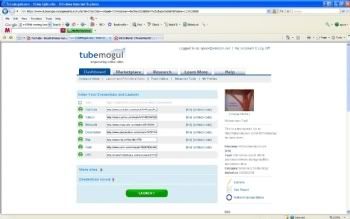
You also need to keep search optimization in mind when you post. Choose your tag words carefully so that viewers will be more likely to find your clips.
Note that posting your video to these video sharing sites makes it easy to embed the clip on a Web page. YouTube creates HTML code that you can cut and paste to put both a player and your video clip on your Web page. You can even choose the format for the video player that appears on your page. Promote your clip by finding other sites that will link to the video's location on your site, or that will embed the video right on theirs.
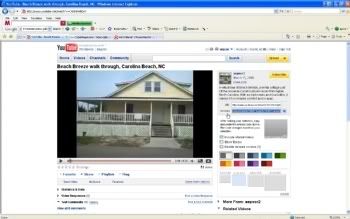 If appropriate, consider sending out a press release announcing your video. Send it to local news outlets if you sell to your local markets. Try low-cost services that will deliver electronic press releases to a broad range of media outlets, such as SBWire or PRFree.
If appropriate, consider sending out a press release announcing your video. Send it to local news outlets if you sell to your local markets. Try low-cost services that will deliver electronic press releases to a broad range of media outlets, such as SBWire or PRFree.
Also, take advantage of the social networking sites available on the Web to promote your video. Put it on your Facebook page. Get people to submit it to sites such as Digg, StumbleUpon, del.icio.us, and Reddit. Just as with a Web site, you need to drive people to your video in order to get them to see it.
Finally, don’t abandon your clip. Nothing dies by itself on the Web, so if your products or services change, or your promotional offer expires, or for some other reason the content of your video clip is no longer current or accurate, remember to take it down from the sites where you posted it. Just like a Web page that is never updated, an out-of-date video can hurt your business rather than help.
But a well-crafted video that gets promoted to your target audience will deliver your message in an efficient and effective way that engages your prospects and boosts your business.
How to Speed Up your Windows XP Netbook?
Most modern desktops and laptops have power to spare, but netbooks are notoriously pokey. Consequently, you should turn off any operating-system features that can make your Lilliputian PC even slower.
If your system runs Windows XP, as most netbooks do, here's an easy way to squeeze some extra speed out of it:
1. Open the Control Panel.
2. Double-click System.
3. Click the Advanced tab, followed by the Settings button in the Performance section.
4. By default, the Visual Effects tab is usually set to Let Windows choose what's best for my computer. Windows knows best?! Hardly. Change the setting to Adjust for best performance. As you'll see, this disables all XP's visual effects.
5. Click OK, then wait a few seconds while Windows readjusts itself. Click OK again to exit System Properties.
While this leaves you with a plainer, less visually exciting Windows, it also lets your netbook devote its minimal processing power to more important things, like running apps and crunching data.

Use Free Web Services like Twitter Topics, Screencasts, and Web Notes to scan local Twitter topics, make HD screencasts, and mark up Web pages.
It's that time again: I've built up a critical mass of free online services to recommend. This week I've got Web sites that let you browse the hot Twitter topics in your city, create high-def screencasts, and mark up Web pages with highlighting and comments.
Happn.In Shows What's Tweeting in Your City
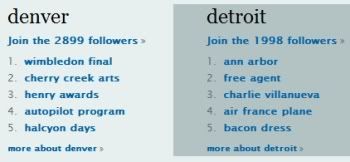
Ever wonder what the folks in your town are tweeting about? Head to Happn.in, which shows the popular Twitter topics for dozens of major cities worldwide.
Just to clarify, this isn't a city-specific search engine. If you merely want to find all tweets pertaining to, say, Las Vegas, any number of Twitter search tools (including Twittter's own) can reveal that information.
Rather, Happn.in shows you the five most common tweets originating from any given city. (Huh. The folks in Atlanta apparently have a lot to say on the subject of long hair.) Click any of the topics to see the actual tweets.
You can also search for phrases or users that have appeared on Happn.in.
Okay, so there's not a lot of practical value here. But anyone into Twitter or, say, anthropology may find this an interesting peek at the tweety underbelly of cities around the globe.
Create a High-Def Screencast
In case you're unfamiliar with the term, a "screencast" is a recording of your desktop. It's an ideal way to demonstrate something, like how to use a complicated feature in Microsoft Office (or how to do file attachments so you don't have to explain it to your mom a 78th time, ahem).
All you do is start your recording, perform the activity one step at a time (narrating along the way if you wish), then stop the recording. The end result is a video you can e-mail to others, post to YouTube, and so on.
You don't need any pricey software or special equipment to create screencasts--just your Web browser, a few minutes of your time, and a service like Screencast-o-Matic.
It's free. There's nothing to install. And it recently added support for high-definition (1280 x 720) recording. You don't even need an account to use it, though you can create a free one if you want to keep tabs on your recordings.
After you finish recording a screencast, you can save it to your PC in MP4 format or upload it to your YouTube account.
I particularly like the way the service highlights mouse clicks and enlarges the cursor so viewers have an easier time tracking what you're doing.
I should note that if you want to add narration to your screencast, you'll need a microphone. If you have a webcam, you're all set. Otherwise, any old mic will do.
Highlight and Mark Up Web Pages
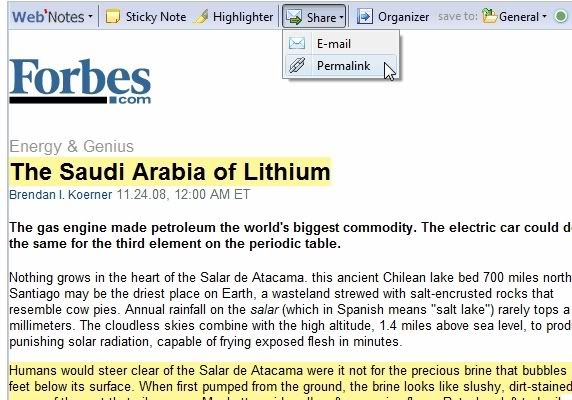
Have you ever wished you could take a yellow highlighter to a Web page--say, a particularly noteworthy passage in, say, a really witty and helpful blog post--so you could easily retrieve the information later on?
That's the idea behind WebNotes, which adds a virtual highlighter and sticky notes to your browsing experience.
The service was designed to help folks like students and researchers mark up Web pages they way they'd mark up books or journals, but obviously it's useful for anyone who wants to record and organize information for future use.
After signing up for a WebNotes account (the Basic service is free), you simply install the WebNotes toolbar in your browser. When you click the Highlighter button, your mouse becomes, well, a highlighter: Drag it across a chunk of text just like you would to select the text.
A click of the Sticky Note button lets you append one of the famous yellow notes to the page, pasting it in the position of your choosing just by dragging and dropping.
Other toolbar options include Organizer, which opens a familiar folder-style interface for organizing your notes; and Share, which lets you e-mail your annotated page or get a permalink if you want to share it that way.
If all this sounds a bit familiar, you may be thinking of Evernote, a popular service that "clips" and organizes Web pages. The difference here is that your markups stay on each page from one session to the next (so long as the toolbar stays installed); you don't have to visit the WebNotes site to see your collection.
Needless to say, WebNotes can really come in handy. If you've ever longed for a highlighter and/or sticky note for a Web site, give this dynamite service a try.
Free Web Services to Make your Online Life Easy
By now you've probably figured out that I love free Web services. I came across even more great online tools recently. Trackle is a beefed-up version of Google Alerts that pulls customized information from the Web. Songkick tracks your favorite bands and lets you know when they're in town. And Ping.fm lets you update all your social networks at once. Read on for details and links.
Trackle: Get Customized Information Automatically
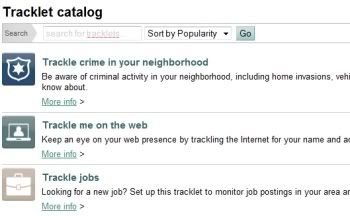
Like Google Alerts on steroids, Trackle is a free service that delivers customized news and information. It culls the Web for just about any topic you can imagine, from crime reports for your neighborhood to low airfares for specific destinations to your own blog contributions and any resulting discussions.
Just sign up for an account and choose the things you want to track. Trackle offers a couple dozen categories, starting with About Me: You on the Web, you in blogs, you in local news, and so on. Others include Finance, Health, Jobs, and Sports.
For each "Tracklet" you set up, you simply supply a few extra bits of information to customize the results: names, keywords, locations, and so on. But this is effortless, and when you're done you can monitor the results in the Your inbox tab.
Trackle can also send you an e-mail or text message when there's a new alert, either one at a time or as part of a daily digest. There's even a vacation-hold option that cleverly suspends notifications while you're on the road.
I'm loving this service. It's much more versatile than Google Alerts, and the prefab Tracklets make it a snap to get all kinds of useful information. Definitely worth a look.
Songkick: Find Concerts for Your Favorite Bands
About a year ago I missed seeing The Swell Season by a matter of days, simply because I didn't know they were playing in my town. Never again.

Songkick is a free service that tracks your favorite bands and artists, lets you know when they're touring near you, and even sends e-mail recommendations for other concerts you might like.
It can also hook you up with tickets (from resellers as well as the likes of Ticketdisaster...er, Ticketmaster), show you concert-related blog posts, and add your personal comments to the artist's profile page.
After signing up, just head to the Tour Tracker and enter the name of an artist. Songkick adds that artist to your list and suggests similar ones you might want to track. Very nice.
You can also download the Songkicker plug-in, which scans your music library (iTunes, Winamp, or Windows Media Player) and automatically adds your artists to the Tour Tracker. It'll even update the Tracker when you add new music to your library.
I had a little trouble getting this to work with iTunes, but only because I used the installer to create my Songkick account. When I created it on the site and then plugged my username and password into the installer, it worked fine.
One of my all-time favorite artists, Brendan Benson, has a new album coming out this summer, and hopefully he'll be touring to promote it. Now that I'm following him in Songkick, I don't have to worry about missing out.
Ping.fm: Update All Your Social Networks at Once

Want to tell the world you just scored tickets to Coldplay? If you subscribe to more than a couple social networks, it might take you longer to post all your updates than it did to buy the tickets. Ping.fm aims to make updates a unified affair: Just send your missive to the service and it'll post it to all your networks.
Ping.fm currently supports over 40 of them, ranging from mainstream networks like Facebook, Twitter, and LinkedIn to lesser-known outlets like Bebo, Brightkite, and Rejaw.
After signing up for an account (Ping.fm is currently in beta), you'll be able to post your updates via e-mail, SMS, instant message, your phone's browser, Skype, and even an iGoogle gadget.
On the Dashboard page (which I found a little overwhelming at first, in part because of all the clutter), just click the posting method you want to use to get the instructions you need, like your unique Ping.fm e-mail address or the iPhone-friendly browser URL.
Ping.fm can automatically take care of things like URL shortening (handy for the likes of Twitter and Rejaw), and it lets you set up posting groups in case you want to hit some, but not all, your networks.
In short, it's a handy little service, one that can definitely save you some time.
Free Online Productivity Tools – Handpicked for You
A while back I mentioned a vexing problem I was having with my speedy new HP desktop: Once a week or so, it would slow to a crawl. I spent weeks trying resolve the problem, but nothing worked. Eventually I threw in the towel, at least for a while.
When I revisited the issue a few weeks later, I couldn't remember what troubleshooting steps I'd tried. I was more or less back to square one. Read on for a terrific free service that helped me get organized to track down my problem, plus a Web site that turns PDFs into text, and an online storage service that acts like an extra hard drive on your computer.
Use Evernote to Organize Your Troubleshooting Efforts
Enter Evernote, which I'm rapidly starting to recognize as one of the Web's all-time best services. Though it's really nothing more than a tag-based note manager, it makes capturing and synchronizing those notes a breeze. And that makes it invaluable for all kinds of organization. (I'm not the only one around here who loves it. Check out BizFeed blogger David Coursey's mash note to Evernote.)
The service provides several ways to add a note to one of your notebooks. You can create text in a Web form (or paste text into it from another source). You can "clip" portions of Web pages using the Evernote bookmarklet for Internet Explorer or the Evernote extension for Firefox. You can use the Evernote desktop app. Finally, you can add notes on your Apple iPhone or Windows Mobile smartphone (which also allows you to upload snapshots, a very handy amenity).
You can assign each note to one or more notebooks and apply one or more tags. But the real beauty of Evernote is the way it keeps all your notes in sync between desktop, Web, and mobile device.
Anyway, back to PC troubleshooting. During my second attempt to fix my problem, I used Evernote every step of the way. While browsing user forums, I "clipped" posts that offered potential solutions. When I made a change to my system, I made note of it in a new note. And holy guacamole, did all this make life easier.
Thus, I highly recommend using Evernote the next time you troubleshoot your own problem. Certainly the service can be used for countless other tasks, but I found it invaluable for this one. Oh, and in case I forgot to mention it, Evernote is free.
Turn PDFs Into Word Documents
Have you ever wished you could edit a PDF in Microsoft Word? Seems like that should be easy enough, especially when you're dealing with a document that's mostly text. Alas, a PDF is really just a collection of images, meaning you can't edit the contents in their native format.
Of course, there are pricey software utilities that will convert a PDF into Word-friendly text. But there's also PDF to Word, a Web service that accomplishes the same thing absolutely free.
All you do is upload your PDF and choose your desired output format: Word or Rich Text Format. Then you sit tight while the service works its magic, eventually sending you an e-mail with a link to download the converted document.
Best bet: Choose Word over RTF. Word conversions end up looking remarkably similar to your original PDFs. Ultimately, the quality varies from one document to another depending on its content, layout, and so on.
This is one seriously handy tool, and you can't beat the price.
Keep Your Files in the Cloud with ZumoDrive
Not enough space on your iPhone for all your music? Need more storage for your tiny netbook hard drive? ZumoDrive promises to solve conundrums like these by keeping your files in the cloud but making them accessible in real-time, just as though they were local. In other words, it's a virtual hard drive that lives online.
When you install the Windows or Mac client, ZumoDrive adds this virtual drive to your system, complete with prefab folders for music, photos, and documents. Just drag and drop your stuff to one of these folders (or create new ones--remember, the virtual drive works just like a regular drive) to copy it to the ZumoDrive cloud.
From there, you can access those files in any Web browser or on any PC that has the ZumoDrive client installed. There's also a free iPhone app that lets you retrieve documents, photos, and music (which you can stream over 3G, EDGE, or Wi-Fi--a great workaround for memory-crunched devices). An Android version is coming soon.
You can get a free ZumoDrive account that includes 1GB of storage--enough for a smattering of files, but insufficient for most photo and MP3 collections. Plans start at $3 per month for 10GB of storage and range up to $80 monthly for 500GB.
I'm still test-driving ZumoDrive, but so far I really like the service. It's a snap to set up and use, and it does solve the problem of storage-challenged PCs and iPhones.
Of course, if all you want is online storage, you can get 25GB absolutely free from Windows Live SkyDrive. But it doesn't work as a virtual drive, which is the core of ZumoDrive's appeal.
Windows Vista’s Disk Defragmenter Help!
For the last couple months I've been troubleshooting a vexing problem on my new quad-core HP desktop: Roughly once per week, the machine would start running as slow as molasses.
And I mean slow: Programs would take several minutes to load, and even simple activities like switching browser tabs were maddeningly sluggish. The system slowdowns appeared to be due to excessive disk activity, at least based on my observations of Windows' Resource Monitor (CPU and RAM activity were more or less normal). Curiously, this behavior would last for several hours, and then the system would be back to normal.
Knowing a thing or two about PCs, I tried all kinds of remedies. I checked for viruses and spyware. I ran memory and hard-drive tests. I uninstalled a few potentially culpable (or so I thought) programs, including HP's junkware. I even disabled a few Windows services (like Search and SuperFetch), which some fellow users suggested could be to blame.
Nothing worked. I even went so far as to wipe the hard drive and reload Windows (Vista x64, in case you were wondering), even though the system was barely a month old. That did the trick--for about a week.
Disk Defragmenter Issue or Vista Glitch?
This got so irksome that I started venting about it on Facebook. And that's when an old high-school buddy (you rock, Scooter!) came to the rescue. He suggested I check Windows' Disk Defragmenter. Sure enough, it was set to run on a schedule, and the last time it ran matched up with the most recent slowdown.
Suddenly it all made sense: The non-stop hard-disk activity, the out-of-the-blue recurrence of the slowdowns, and the eventual return to normal. The only thing I couldn't figure out was why I never spotted Disk Defragmenter when I was poking around Task Manager. It was as though it was running so far behind the scenes as to be invisible.
I've since disabled the feature, and to date I haven't had a single slowdown. Granted, it's barely been two weeks, but I'm 98 percent sure this was the root of the problem.
What about keeping my hard drive defragmented? I can do that manually, once a month or so, on my schedule. In the meantime, where do I file a bug report with Microsoft? I suspect this might be a glitch in the 64-bit version of Vista.
Alternatives to Vista's Defrag Tool
Hard drives do indeed get fragmented over time, which is why defrag utilities exist. I'm so done with Microsoft's, but in an impressive display of perfect timing, our own Preston Gralla just wrote up a splendid (and free) alternative: Smart Defrag. Most attractive feature: "Auto Defrag, which defragments your hard disk only when you computer is idle, so that you don't interrupt or slow down any work."
Preston also recommends Defraggler, which he says is better than Windows' own defragment utility in several ways. First off, this download scans your disk faster, which anyone with a large hard disk will certainly welcome. In addition, it can defragment individual files instead of your entire hard disk, and it's more entertaining to watch than the built-in utility.
Need even more options? Auslogics Disk Defrag is another popular freeware defragger. You might also want to browse our file collection, "Low-Cost Utilities Defrag RAM and Hard Drives."
Quick Fixes and Troubleshooting Tips
Troubleshoot PC Performance With ProcessScanner
Try this: Press Ctrl-Alt-Del (and then click Task Manager, if you're running Windows Vista), then click the Processes tab. Ever wonder what all those items are? You should, especially if you're trying to troubleshoot a slow or malware-infested system. The list represents every single process that's currently running--good, bad, and potentially dangerous. Of course, you'll be hard-processed to figure out just what all those processes actually are. Enter ProcessScanner, a free utility that scans your PC and gives you a detailed report about each process: how much memory it's using, whether it's a security threat, and so on.
The program pairs with ProcessLibrary.com (where you can type the name of any individual process and get an instant description), tapping the latter's database to present detailed scan results in a browser window.
Upon reviewing the report, you may find apps you want to uninstall to improve performance or even malware that needs to be eradicated. This is definitely a worthwhile tool for any diligent Windows user. I just made it a permanent addition to my utilities arsenal.
A Quick Fix for Slow Internet Access
This morning a neighbor asked me if my Internet access was really, really slow the last couple days. (We subscribe to the same ISP.) I said no, it's been just fine. Then I offered him the same suggestion I offer most folks who complain about connectivity problems: power-cycle your modem and router.
In other words, disconnect the power cords from both, wait about 10 seconds, and then plug them back in. In a minute or two, your network will be up and running again, and your Internet access might be its good old speedy self. I say "might be" because there are loads of other possible culprits for pokey Internet connections.
For example, you might have a spyware problem. Windows' Internet settings might be FUBAR (or at least less than optimal). If you're connecting via a wireless router, there could be range issues (see "How to Troubleshoot Your Home Network" for help with that one).
In most cases, however, it's probably just a router and/or modem in need of rebooting. For the record, my neighbor told me the power-cycling trick worked like a charm. Hmm, maybe I should send him a bill?
Open .docx Files Even if You Don't Have Office 2007
Another version of Microsoft Office, another set of file-compatibility hassles. (No, really, thanks a ton, Microsoft.) Office 2007 brought with it the Docx format, which can't easily be opened by anyone who doesn't also have Office 2007.
Option #1: Install the succinctly named Microsoft Office Compatibility Pack for 2007 Office Word, Excel, and PowerPoint File Format. It enables older versions of Office to open Office 2007 documents, and it does all the necessary conversion behind the scenes: no input required from you. (Just make sure you've installed the latest service pack for your version of Office, otherwise the Compatibility Pack won't work.)
Option #2: If you're a Firefox user, install the OpenXML Viewer extension, which lets you open Word 2007 files right in your browser with all the formatting and layout preserved. You can't edit the document, but at least you'll be able to view it.
Option #3: Upload the file to Docx Converter. In short order you'll receive an e-mail with a link to converted version of the file.
Boot Faster With Startup Delayer
Think about what would happen at the airport if every plane tried to take off at the same time. Chaos, that's what. And yet that's the situation when a Windows PC boots: Every installed program tries to run itself at virtually the same time. As a result, your once-peppy machine can take 5 or 10 agonizing minutes to start up. What you need is a little air-traffic--make that software-traffic--control.
Enter Startup Delayer, which does exactly what its name suggests: delays startup programs so they don't run until later. The end result: Your PC boots much more quickly.
The utility presents you with a list of all the programs that start when your system does. To set a delay for any of them, just drag it to the white bar at the bottom of the window. You'll see a line representing the program; drag it left or right to decrease or increase the delay. Repeat this for other programs you want to postpone.
For example, if you have iTunes installed, you'll see a startup program called iTunesHelper.exe. Unless you plan to connect your iPod or run iTunes the moment your PC boots, why not delay this applet for four or five minutes? Same goes for things like LightScribe Control Panel and Google Update. Delay those for, say, seven minutes and eight minutes, respectively. Don't mess with programs you don't recognize, which might be integral to system operation, but the devils you know can easily be put off till later.
Startup Delayer is a freebie, and it's the best way I know of to speed up a slow-booting PC. It's a must-have for anyone who installs a lot of software.
Have a Home Theatre? – Take a look at these Power – Saving Tips
HDTVs are energy gluttons, but you can help them consume less.
 Large high-definition televisions are voracious electricity consumers. Some 50-inch plasmas demand in excess of 400 watts of power when turned on. That's more than a good-size, modern refrigerator requires, though the refrigerator stays on 24/7, so it probably devours more energy overall. The other components of your home theater--the DVR, the Blu-ray Disc player, and the separate surround-sound amplifier and speakers--have their own power demands. And the various parts of your home entertainment system suck juice even when they're "off," so that they can start up more quickly and so that you can turn them on via the remote control.
Large high-definition televisions are voracious electricity consumers. Some 50-inch plasmas demand in excess of 400 watts of power when turned on. That's more than a good-size, modern refrigerator requires, though the refrigerator stays on 24/7, so it probably devours more energy overall. The other components of your home theater--the DVR, the Blu-ray Disc player, and the separate surround-sound amplifier and speakers--have their own power demands. And the various parts of your home entertainment system suck juice even when they're "off," so that they can start up more quickly and so that you can turn them on via the remote control. To minimize your home-theater bills, you need to examine both what you buy and how you use it. The good news is that you don't have to cut back on your entertainment hours in order to save money and to reduce your carbon footprint.
Buy Green
Here are some guidelines to consider when you're shopping for an HDTV.
Remember that small is beautiful: Everyone loves to watch a wall-size picture, but a bigger screen isn't better for the environment. On average, according to a study conducted by CNet, 42-inch plasma TVs use of 271 watts of electricity, versus 341 watts for 50-inch models. That's a difference of more than 20 percent in the smaller screen's favor.
Buy the right technology: Avoid plasma and you'll save electricity. A typical 52-inch LCD TV, uses 278 watts of power--only a tad more than a typical 42-inch plasma. Rear-projection sets (I know, they're not cool) save even more energy: On average, a 56-inch DLP TV runs at 171 watts. The new LED-lit LCDs save power, too. PC World Test Center tests show that the 55-inch Samsung LN55A950, the first such television that we've gotten our mitts on, uses about 38 percent less power than most 50-inch HDTVs.
Look for the Energy Star 3 label: When the Energy Star label appears on a TV, it means that the set lives up to the EPA's standard for energy efficiency. But some companies go beyond that standard. Sony, for example, says that all of the 1080p models in its 2009 lineup surpass Energy Star 3.0 requirements by 15 percent. Sony's VE5 Eco line goes even further; the 40-inch VE5 can have a power savings topping 50 percent, and the 52-inch model can save 65 percent. Check the Energy Star Web site for a list of qualifying HDTV models.
Look for the manufacturer's "green" angle: Many manufacturers have gone to great lengths to improve the energy efficiency of their 2009 models. Besides watching for the Energy Star designation, look for other energy saving options that a manufacturer may tout. For example, models in Sony's Bravia VE5 series--the Bravia KDL-52VE5, the Bravia KDL-46VE5, and the Bravia KDL-40VE5--feature high-efficiency HCFL backlighting, which uses reduced-size cathode tubes to improve power efficiency by 40 percent over other Sony LCDs. They also feature a 0-watt standby power switch, a light sensor with dynamic backlight control to reduce the screen's brightness for use in dim environments, and a motion sensor that turns off the TV if it doesn't detect any movement for a specified period of time.
Watch the power consumption of your components: When buying components, pay attention to the relative power supply and the reported watts consumed for each device. You can find these specs for many devices, including Blu-ray players and DVRs, on the back of the unit. That's how I found out that my Sony Blu-ray player uses 25 watts and that my Dish Network DVR uses 120 watts. Manufacturers' Web sites sometimes list this information, but it can be buried in obscure places. Though amplifiers/receivers proudly advertise their wattage per channel (more is better for sound quality), you can always save power by lowering the volume.
DVRs are a special case when it comes to power savings. You can't completely shut off a DVR without losing its scheduled recording ability, but an eco-conscious DVR will consume only a trickle of power when "off" and waiting for a signal from its timer or from the remote to come back to life. The popular DVR TiVo doesn't quite reach this ideal mix: Even in its hard-to-reach standby mode, it keeps spinning the hard drive and recording whatever is on two different channels. TiVo says that the DVR consumes about 39 watts when on, and "slightly less" in standby mode.
Watch Green
Whatever you own, adopting a few good habits will help you cut down on the amount of juice you use.
Turn down the brightness: Televisions leave the factory too bright because they're optimized for use in showrooms, not in your living room. Lowering the brightness setting will save electricity, increase the set's lifespan, and produce a better-looking picture.
Look for energy savings options: Many newer TVs may have options that let you sacrifice power for performance. You'll probably end up with an image that isn't as bright (as recommended above) and a TV that takes a few more seconds to warm up when you turn it on. But it's well worth it.
Use the TV's built-in speakers: Your separate surround-sound amplifier and speakers greatly enhance a big action flick, but they add nothing to the director's commentary. So turn on the amplifier only when the big sound makes a difference.
Truly turn off your gear: Your HDTV, amplifier, cable box, DVR, and DVD or Blu-ray Disc player all suck electricity when they're switched "off." Of those, only your DVR (and maybe your cable box, if it's separate from the DVR) has a legitimate reason to remain on call in this way: Without a stream of constant power, the DVR can't turn itself to fully active mode to record on schedule. The only advantage you get from the other gadgets that burn electricity continuously is the minor convenience of being able to turn them on with a remote and have them start up faster.
Adding a second surge protector to your home-theater setup will put a stake in the heart of those vampires. Plug your TV, disc player, and amplifier into one protector, and mount that one in a convenient location. Then plug your DVR and anything else into another. When you're done watching TV, turn off the first protector.
Alternatively you can achieve the same result with a single surge protector, but it has to be a smart one. The Monster GreenPower Digital PowerCenter MDP 900 and the Belkin Conserve AV can shut off some of the plugs on their strip while leaving others live.
Use that smaller TV: If you own two televisions, use the smaller, more modest one to view size-neutral programs. Case in point: Jon Stewart doesn't look any better on a 50-inch screen. Really.
Relax and enjoy the show: After all, if you don't like what you watch, you're wasting your time as well as your electricity.